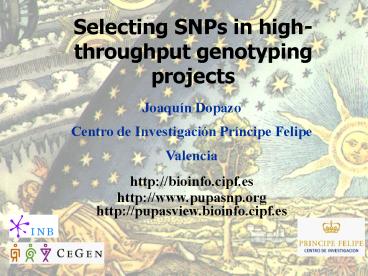Selecting SNPs in highthroughput genotyping projects - PowerPoint PPT Presentation
1 / 9
Title:
Selecting SNPs in highthroughput genotyping projects
Description:
Selecting SNPs in high-throughput genotyping projects. Joaqu n Dopazo ... First step: High throughput search for putative functional SNPs - PupaSNP ... – PowerPoint PPT presentation
Number of Views:80
Avg rating:3.0/5.0
Title: Selecting SNPs in highthroughput genotyping projects
1
Selecting SNPs in high-throughput genotyping
projects
Joaquín Dopazo Centro de Investigación Príncipe
Felipe Valencia http//bioinfo.cipf.es http//www.
pupasnp.org http//pupasview.bioinfo.cipf.es
2
Design and implementation of a pipeline for
high-throughput genotyping at the CeGen. (CeGens
pilot project)
Problem 1 feed the monster. E.g. Illumina
150.000 genotipes at a time
Problem 3 query the database...
Problem 2 store results...
Computer-aided selection. PupaSNP and
PupasView Conde et al. 2004, 2005, NAR
Cancer SNPs DB server
Experimental design (linkage, pathway, etc)
...and submit to analysis programs
...along with clinical data
October 2004 45.000 SNPs designed
LD, Case-control, haplotypes, ODD ratios, etc.
3
Genotyping using SNPs
- Simplest and most frequent type of DNA variation
in humans. (Collins et al., Nature, 2003) - Valuable as genetic markers due to their
widespread distribution. (Risch, Nature, 2000) - Linkage analysis succeed in identifying genes
responsible for mendelian traits (diseases,
susceptibility to drugs, etc.) (Risch, Nature,
2000) - In complex multifactorial diseases, linkage
analysis has not been so successful due to the
weakness of the associations. (Hugot et al.,
Nature, 2001) - SOLUTIONS
- Increasing sample size (obvious, although usually
not possible at the required level) - Functional SNPs will be an important factor for
increasing the sensitivity of association tests.
(Hugot et al., Nature, 2001) - How to predict functionality?
4
SNPs that can affect transcription and/or gene
products
Triplex-forming sequences (Goñi et al. Nucleic
Acids Res.32354-60, 2004)
Human-mouse conserved regions
Amino acid change
Splicing inhibitors
Transfac
TFBSs
(Wingender et al., Nucleic Acids Res., 2000)
ESE (exonic splicing enhancers) motifs recognized
by SR proteins
Intron/exon junctions
(Cartegni et al., Nature Rev. Genet., 2002)
(Cartegni et al., Nucleic Acids Res., 2003)
5
Pipeline of Analysis
Objective Linkage, association, ...
Analysis of the results
Selection of SNPs
Genotyping
- Problem high-throughput selection of SNPs.
- First step focusing on lists of genes.
- In silico search of SNPs with potential
phenotypic effect PupaSNP Finder. - Second step focusing on genes.
- Filter SNPs using information on functionality,
frequencies and LD PupasView.
6
First step High throughput search for putative
functional SNPs - PupaSNP
for...
linkage
or
association
http//www.pupasnp.org
(Conde et al., Nucleic Acids Res., 2004)
7
PupaSNP Results
8
PupasView sequential filtering of SNPs using
information
Information is applied as sequential filters
(Conde et al., Nucleic Acids Res., 2005)
9
Cancer SNP DB one of the pilot projects of CeGen































